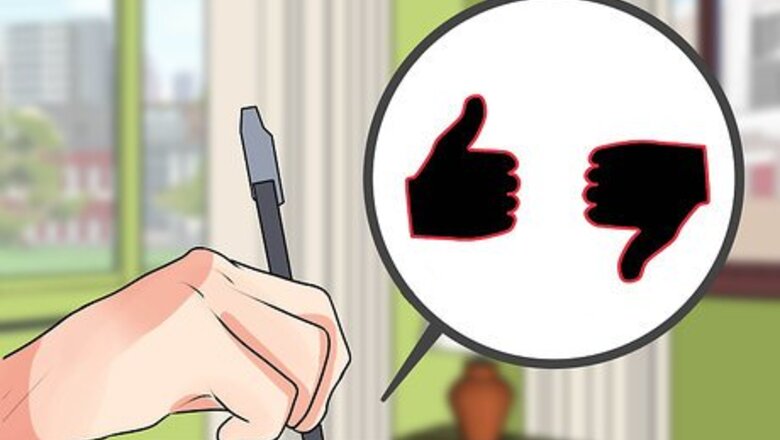
views
Creating Structure

Draft a set of rules. This set of rules should be written with consideration of your child’s age. Younger children will need simple, straightforward rules, while older children can begin to understand more complex rules, that may be flexible depending on the situation. The list should prioritize those rules that are based on the naughty behaviors your children are demonstrating. For example, if your child gets aggressive when they don’t get what they want, then you should draft a rule that makes this behavior strictly forbidden. The list should include other things you expect your child to do each day, such as brushing their teeth, making their bed, putting away their toys, etc. Encourage the child to help you make the rules, such as by asking them questions about what types of behavior are acceptable. For example, you could ask the child, “What are some of the things we should do before school?” Sit down and discuss this list of rules with your child so that they know what is expected of them.
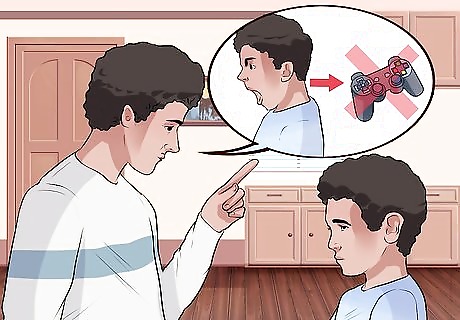
Attach immediate consequences to each rule. Not only do you need to have a clear set of rules that your child can understand and follow, but you should also make clear what will happen when one of the rules is broken. If a higher priority rule is broken (e.g. if your child hits you), then the consequence should be more severe than if the child breaks a less high priority rule (e.g. doesn’t make up the bed in the morning). Never hit or spank your child. Not only does this damage your relationship with them, but it also shows them that they can get what they want by hitting smaller, weaker people. Make sure to discuss each rule together with the consequence that will occur if they break the rule. This way, they understand what to expect. For older children, you may even discuss the consequences of breaking a rule together and ask for their input on what some appropriate consequences might be.

Give them things to do. Children who are bored will find ways to entertain themselves. While it is not necessarily a bad thing for children to use their own imaginations when it comes to entertaining themselves, it can also cause them to act out and behave in ways they know they shouldn’t. For example, if your child will be home all day long, try to schedule different activities. Let them color with a coloring book and crayons for an hour while you do what you need to do. Spend some time playing together with them, ask them to help you make lunch, or do some finger painting outside together. It’s good to give your child some time to play by themselves, but it is also important to spend time playing together and nurturing your relationship.

Have a schedule. In addition to giving your child plenty of tasks, you should have a routine that you stick to each day, especially if your child is not yet of school age. This will help them understand what to expect and when to expect it, reducing the likelihood of boredom or frustration. For example, have them take their nap at the same time each day. If they are of school age, have them wake up at the same time each day, even weekends. Create a routine. For example, having them take their bath each day before bedtime, which will also signal to them that it’s time to wind down. If you are not able to do something that is on the schedule, then make sure to provide an alternative time for the activity and keep your promise to help build trust.

Consider the age of the child. Obviously, as the child grows, you will have to re-think the rules and the consequences attached to them. Therefore, it is important to remember that younger children won’t be able to process complex rules with contingencies, while older children can be given a bit more control and independence. Remember—not all bad behavior is actually bad behavior. Sometimes, these behaviors are simply immature coping mechanisms, like tantrums and meltdowns. Children between 0 and 2 will not be able to understand a set of rules. Instead, if there are things you want them to avoid, it is best to keep those things out of reach. If they get into something, gently but firmly tell them, “No,” and distract them with another activity. You can use timeouts of a few minutes to help them associate certain actions (such as biting or hitting) with a negative consequence. Timeouts of longer than a few minutes will not be effective for children at this young age. Children between the ages of 3 and 5 will be able to understand the connections between what they are doing and the consequence that follows. If the child misbehaves, explain what they did wrong, and warn what will happen if they do it again. The next time it happens, remind them of what you told them and apply the consequence. From ages 6 until 8, timeouts are a good way of enacting discipline. Make a designated timeout spot that will be free from any distractions (such as TV, computer, etc.) so that the child will need to think about what they did. Again, remember not to take it to the extreme. A timeout of 6 to 8 minutes should be sufficient. If the child throws a tantrum, tell them they will remain in the timeout until they are able to calm themselves. Beginning at the age of 9 up until 12, you can begin to use natural punishments, in addition to enacted discipline, such as grounding them for a week if they break a rule. For example, if your child failed to do his homework for bed, let him learn what happens when he returns to school without doing his homework. Beginning at this age, children should begin to learn for themselves what happens when they don’t do what is asked of them. If your child is a teenager, you will need to re-establish the rules so that they can exercise their own control and independence, within reason. If a rule is broken, there should still be consequences, but as before, it is important to explain to them why they should stick to the rules. For example, if they come home past curfew without calling, explain why that is very worrisome for you. Make sure to ask the teen for their input about the consequence as well.
Dealing with Tantrums

Walk away from the behavior. If your child is throwing a big tantrum (e.g. yelling, screaming, crying, banging fists, etc.) the best thing you can do is remove the audience that they are performing for. This may only be you, but it may also be your other children, friends of your child, grandparents, etc. If you are at home, and your child is not in danger of hurting themselves, then suggest that everyone go do something else in a different room for a while. If you are not at home, then remove your child from the public place as quickly as possible. For example, if you are at the grocery store, take the child to the car. Make sure to prioritize correcting misbehavior over the task you are doing. For example, if you are out grocery shopping with your child and they are misbehaving, then you may need to stop what you are doing for a moment and address the behavior. Consider what strategies you can use in these types of situations so you will be prepared.
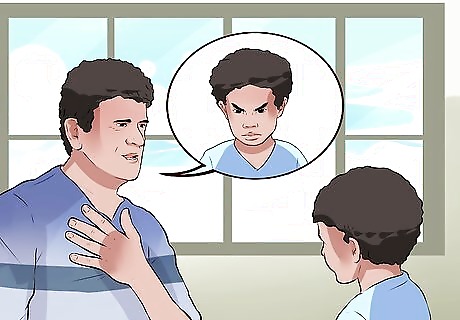
Let them know you understand that they’re upset. If your child is under 4 years old, you can let them have their tantrum alone, in a safe place. Check on them every few minutes, and tell them that you are aware that they are upset, and that you can talk with them about why they are upset when they are finished with the tantrum. If a child younger than 4 reacts violently to you, either by hitting, kicking, scratching, or biting you, put them in a time out. Tell them that such behavior will not be tolerated. Once the child has calmed down, listen to what they have to say. Tell them that throwing a tantrum is not the best way to deal with their problem. Don’t fixate on this point, however; explain a better way to deal with it, and move on.

Remind them of the rules. If the child is over 4, and they are throwing a tantrum, gently remind them of the rules. Explain to them that they have 2 options: they can either choose to stop the behavior and do something that they like that is also within the rules, or they can continue with their behavior and not have enough time to do something they would enjoy. Once they have calmed down, discuss better ways that they can express their feelings in the future. Ask them to make suggestions about how they think they could have reacted better.

Distract them. Sometimes tantrums can be so severe that no amount of reasoning seems to do any good. In this case, you can try to distract them with a favorite book, or a pacifier, if they use one. Once the tantrum is over, it is still important to discuss better ways of dealing with problems in the future.

Don’t give in. Especially when a child throws a tantrum in a public place, such as the grocery store, it may seem that the best thing to do is to simply give them what they want so they will stop embarrassing you. However, this is a bad idea, and will only reinforce that throwing a tantrum will get them what they want. It may seem like a good idea at the time, but you will be sorry you did it the next time they throw a tantrum in the exact same situation.
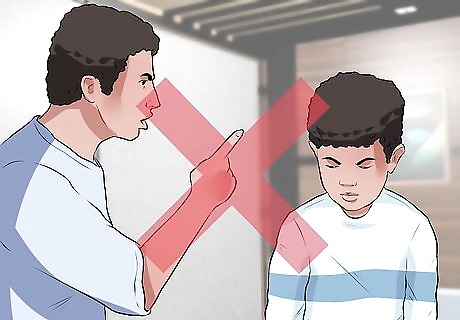
Don’t yell at them. When a child is having a tantrum, and you are getting frustrated with them, it can be very tempting to yell at them to knock it off. However, at this point, yelling is unlikely to help the situation, and will likely only increase the stress levels of the child, and of yourself. Keep your tone calm and even. If you feel like you're going to yell, then don’t say anything at all. If you're losing your temper, it may be best to walk away for a few minutes, provided your child is not in danger of harming themselves.

Remove the thing that caused the tantrum. When the child has calmed down, you should remove the item that caused the tantrum, and replace it with something quiet and relaxing for the child to focus on. For example, if your child was upset because they wanted a candy bar, move them away from the candy, and have them look at a magazine while you finish shopping.

Remind the child that you love them. Tell the child that while you didn’t love their behavior, you do love them and that you always will. It is important for a child to understand that your love for them is not reliant upon their good behavior. For example: You could say, “That tantrum back there was pretty bad. I hope you understand that while I don't like it when you yell and scream like that, I do love you very much—even when you throw tantrums.” Don’t say, “You were a very bad kid back there. Sometimes, it’s hard to love you when you act like that.”
Dealing with Bad Behavior
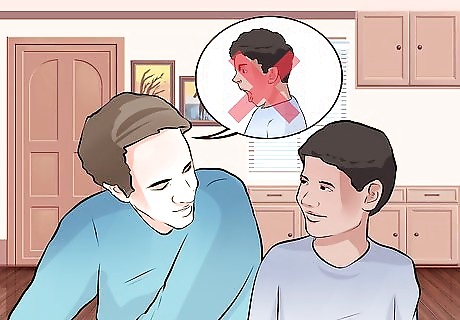
Tell your child what you would like them to do. If your child is behaving badly or has done something you don’t want them to do, don’t simply say, “Stop that!” Instead, tell them what you would like them to do, and what the reward will be for engaging in this different behavior. For example, if they have yelled at their younger sibling, say, “Remember that we have a rule about yelling. If you’re feeling upset by your sister, I would like to see you walk away from her instead of yelling. When I see you do this, I will take you to see that movie you’ve been asking to see.” You can also give the child a chance to tell you what is going on in their minds. For example, you could say, “What is your sister doing that is making you feel like you want to yell at her?” This will give them a chance to feel understood instead of just redirecting their behavior without acknowledging that they are upset. Be very clear and direct when telling your child what you'd like them to do.

Remind them of the rules. If your child is doing something that is against the rules, remind them of that rule, and the consequence for breaking it. Explain to them that if they continue with the rule-breaking behavior, that you will be forced to enact the consequence. At this point, you can give them a choice. Explain to them that they can either stop the behavior, not receive the consequence of that behavior, and do something else, or they can continue with the behavior and deal with the consequence of that behavior.

Follow through. Sometimes enforcing the consequences of rule-breaking can be a hassle. However, if the child has broken a rule it is important that you follow through with what you said, and that you do so in a timely manner. If you don’t, the child may learn that you don’t stick to the rules yourself, so why should they? If for some reason, you can’t immediately enact the consequence, explain to the child that you will still follow through, but that it will have to be at a later time. Explain the reason for the delay so that they understand that they aren’t getting away with their bad behavior. Follow through on any rewards you promise your child as well. For example, if you promise to take them for ice cream if they behave, then take them for ice cream.

Be consistent. This can be very frustrating, especially because it may mean dealing with the same behavior several times before it stops, but it is important that your child understand that there will be consequences every time a rule is broken. Make sure to follow through by explaining what the rule is, how the child broke it, and what the consequence now is. For example, if the child hits another child, immediately place them in time out where they will not be able to play for 5 minutes. If the behavior is repeated, repeat the consequence. Do this as often as necessary so that your child understands that bad behavior always has a consequence.
Reinforcing Good Behavior

Ask the child to help come up with rewards for their good behavior. You can sit down with them, and write down several different things they’d like to do, meals they’d like to eat, and places they’d like to visit. Have them tell you which things they really, really would like, and rank them from highest priority to lowest priority. When your child does something really great, you can reward them with their top reward. For example, if their teacher reports that they have behaved very well all month at school, you could take them to the zoo, if that was the thing they most wanted. You can use the other rewards to reward them for other good behavior, such as making up the bed each day for a week without being asked.

Praise them verbally. If you notice your child behaving particularly well, tell them so. Thank them for behaving so nicely, and give them a hug. Reward them with something from the list, too. If you never reward them for their good behavior unless they remind you of your agreements, it may demonstrate to them that you're not really paying any attention.

Spend time with them. Most children really enjoy doing things with parents and caregivers. If your child is behaving well, show them that you appreciate it by doing things together with them. Allow them to take more responsibility with tasks. This will show them that you notice their good behavior, and are rewarding it. For example, if your child is behaving very well, ask them to come plant some flowers in the garden with you. Then, let them take charge (within reason). Let them choose where to plant the flowers, let them place the seeds into the hole, and cover it up.
Taking Care of Children That Are Not Your Own

Discuss discipline with the parents. It is important that you discuss how the child should be disciplined if the rules are broken with the parents of the child. Ask them how they discipline the child, and what their expectations are when it comes to you taking care of the child and applying discipline if the rules are not followed. It is important to discuss this with the parents so that there are not any misunderstandings. If you don’t discuss this, you may use different discipline techniques than the parents. Not only will this cause confusion and stress for the child, but it may also cause tension in your relationship with the parents.

Set rules. In all likelihood, the rules you use with the child will be the same as the ones the parents use. However, you might ask the parents to include one or two new rules to the list that relate specifically to how the child is expected to behave when you are the caretaker. For example, you might include a rule that explicitly states that when you're taking care of the child, you are in charge, and the child is expected to do as you say. It is probably also a good idea to sit down with the child (if they are old enough to understand), with the parents, in order to go over all of the rules (including any new rules). This will help the child understand that the rules apply in your presence, and will let them know that you are well aware of the rules, too. If the child protests, remind the kid that you don't make the family rules, but it's your responsibility to follow them.

Be consistent. This is perhaps the most important thing to remember. Sometimes it will be easier to just let the child do what they want. However, it is important that you also follow all the rules, and apply consequences for the rule if it is broken. This is important because if the child knows you don’t follow the rules rigidly, then they are more likely to misbehave in your presence. Additionally, it is also likely that they will begin to question the authority of their parents. If you're not sure whether or not a child's request or behaviour violates a family rule, be honest and tell the child you'll have to wait and ask the parents when they get home.

Make suggestions to the parents. If you find that there are certain rules that aren’t working, or if you have suggestions for new rules that you think could help a naughty child learn to behave, then talk with the parents about it. When doing so, be respectful. Don’t tell them, “You’re doing this, and it’s dumb. It’s not working, you should do this.” Instead, if you find a rule isn’t working and want to suggest a new idea, say, “I’ve been working with [insert child’s name] about not breaking this rule, but he seems to be having trouble with it. What would you think about trying out this approach…?” You don’t want to make the parent feel as though you are insulting their parenting. Rather, you want to show that you're interested in helping improve if there is a way to do so, but without treading on their authority.

Keep the parents updated. When you are finished with your caregiving duties, you should briefly chat with the parent about how the child behaved, and if any disciplinary action was needed. This will help the parents understand what is working and what isn’t, and will also allow you a chance to suggest any ideas you may have.
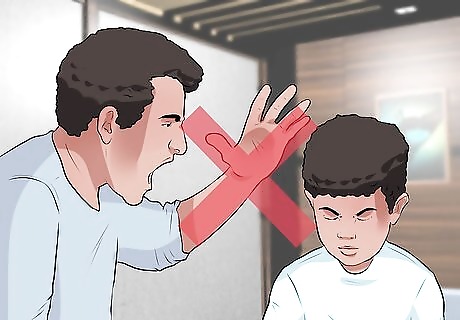
Avoid violence. Just as you should never hit your own children as a means of discipline, you should certainly never use physical violence to discipline the children you are taking care of. If the parents suggest using violence as a means of discipline, politely explain to them the problem with this type of discipline. Respectfully explain that you will not engage in this type of discipline, and suggest an alternative. If they insist, you should probably consider backing out of the agreement. If you're worried for the safety of the child, contact the authorities. Unfortunately, it is legal to hit children in all US states, but the law varies from state to state about what is legal and what isn't. If you're concerned, it is better to contact the authorities than to stand aside and let a child endure abuse.



















Comments
0 comment